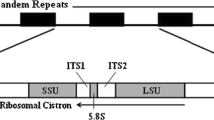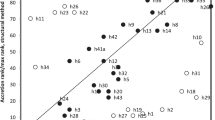Summary
The DNA sequence of the small-subunit ribosomal RNA coding region for the cycadZamia pumila L. was determined. TheZamia smallsubunit rRNA was found to be 1813 nucleotides in length and approximately 92% identical to published angiosperm small-subunit rRNA sequences. Conserved regions interspersed with variable regions are observed corresponding to those found in other eukaryotic small-subunit sequences. Using representatives from protist, fungal, plant, and animal groups, a distance matrix was constructed of average nucleotide substitution rates for pairs of organisms. Phylogenetic trees were inferred from similarities between sequences. The sequence ofZamia represents the earliest divergence from the higher plant lineage reported to date for small-subunit rRNA data. Inferred phylogenies also support a monophyletic origin for the angiosperms consistent with studies citing phenotypic characters.
Similar content being viewed by others
References
Benton WD, Davis RW (1977) Screening λgt recombinant clones by hybridization to single plaques in situ. Science 196:180–182
Birnboim HC, Doly J (1979) A rapid alkaline extraction procedure for screening recombinant plasmid DNA. Nucleic Acids Res 7:1513–1523
Bremer K (1985) Summary of green plant phylogeny and classification. Cladistics 1:369–385
Bremer K, Wanntorp H (1978) Phylogenetic systematics in botany. Taxon 27:317–329
Brimacombe R, Stiege W (1985) Structure and function of ribosomal RNA. Biochem J 229:1–17
Crane PR (1985a) Phylogenetic analysis of seed plants and the origin of angiosperms. Ann Mo Bot Gard 72:716–793
Crane PR (1985b) Phylogenetic relationships in seed plants. Cladistics 1:329–348
Dale RMK, McClure BA, Houchins JP (1985) A rapid singlestranded cloning strategy for producing a sequential series of overlapping clones for use in DNA sequencing: application to sequencing the corn mitochondrial 18S rDNA. Plasmid 13:31–40
Doyle JA (1978) Origin of angiosperms. Annu Rev Ecol Syst 9:365–392
Eckenrode VK, Arnold J, Meagher RB (1985) Comparison of the nucleotide sequence of soybean 18S rRNA with the sequences of other small-subunit rRNAs. J Mol Evol 21:259–269
Eckenwalder JE (1980) Taxonomy of the West Indian cycads. J Arnold Arbor Harv Univ 61:701–722
Elwood HJ, Olsen GJ, Sogin ML (1985) The small subunit ribosomal RNA gene sequences from the hypotrichous ciliatesOxytricha nova andStylonychia pustuiata. Mol Biol Evol 2: 399–410
Fitch WM (1976) The molecular evolution of cytochrome c in eukaryotes. J Mol Evol 8:13–40
Fitch WM, Margoliash E (1967) Construction of phylogenetic trees: a method based on mutation distances as estimated from cytochrome c sequences is of general applicability. Science 155:279–284
Foster AS, Gifford EM (1974) Comparative morphology of vascular plants, ed 2. WH Freeman, San Francisco
Frischauf A, Lehrach H, Poustka A, Murray N (1983) Lambda replacement vectors carrying polylinker sequences. J Mol Biol 170:827–842
Gutell RR, Weiser B, Woese CR, Noller HF (1985) Comparative anatomy of 16-S-like ribosomal RNA. Prog Nucleic Acid Res Mol Biol 32:155–216
Hasegawa M, Iida Y, Yano T, Takaiwa F, Iwabuchi M (1985) Phylogenetic relationships among eukaryotic kingdoms inferred from ribosomal RNA sequences. J Mol Evol 22:32–38
Herzog M, Maroteaux L (1986) Dinoflagellate 17S rRNA sequence inferred from the gene sequence: evolutionary implications. Proc Natl Acad Sci USA 83:8644–8648
Hori H, Osawa S (1979) Evolutionary change in 5S RNA secondary structure and a phylogenetic tree of 54 S RNA species. Proc Natl Acad Sci USA 76:381–385
Hori H, Lim B, Osawa S (1985) Evolution of green plants as deduced from 5S rRNA sequences. Proc Natl Acad Sci USA 82:820–823
Jackson M, Ingle J (1973) The interpretation of studies on rapidly labeled ribonucleic acid in higher plants. Plant Physiol 51:412–414
Jukes TH, Cantor CR (1969) Evolution of protein molecules. In: Munro HN (ed) Mammalian protein metabolism. Academic Press, New York, pp 21–132
Kimura M, Ohta T (1972) On the stochastic model for estimation of mutational distance between homologous proteins. J Mol Evol 2:87–90
Klotz LC, Blanken RL (1981) A practical method for calculating evolutionary trees from sequence data. J Theor Biol 91:261–272
Lehrach H, Diamond D, Wozney JM, Boedtker H (1977) RNA molecular weight determinations by gel electrophoresis under denaturing conditions, a critical reexamination. Biochemistry 16:4743–4751
Lumsden J, Hall DO (1975) Superoxide dismutase in photosynthetic organisms provides an evolutionary hypothesis. Nature 257:670–672
Maniatis T, Hardison RC, Lacy E, Lauer J, O'Connell C, Quon D, Sim DK, Efstratiadis A (1978) The isolation of structural genes from libraries of eukaryotic DNA. Cell 15:687–701
Maniatis T, Fritsh EF, Sambrook J (1982) Molecular cloning: a laboratory manual. Cold Spring Harbor Laboratory, Cold Spring Harbor NY
Mankin AS, Skryabin KG, Rubtsov PM (1986) Identification of ten additional nucleotides in the primary structure of yeast 18S rRNA. Gene 44:143–145
Martin PG, Dowd JM (1986) A phylogenetic tree for some monocotyledons and gymnosperms derived from protein sequences. Taxon 35:469–475
McCarroll R, Olsen GJ, Stahl YD, Woese CR, Sogin ML (1983) Nucleotide sequence of theDictyostelium discoideum smallsubunit ribosomal ribonucleic acid inferred from the gene sequence: evolutionary implications. Biochemistry 22:5858–5868
Messing J (1983) New M13 vectors for cloning. Methods Enzymol 101:20–78
Messing J, Vieira J (1982) A new pair of M13 vectors for selecting either DNA strand of double-digest restriction fragments. Gene 19:269–276
Messing J, Carlson J, Hagen G, Rubenstein I, Oleson A (1984) Cloning and sequencing of the ribosomal RNA genes in maize: the 17S region. DNA 3:31–40
Mishler BD, Churchill SP (1985) Transition to a land flora: phylogenetic relationships of the green algae and bryophytes. Cladistics 1:305–328
Olsen GJ, Sogin ML (1982) Nucleotide sequence ofDictyostelium discoideum 5.8S ribosomal ribonucleic acid: evolutionary and secondary structural implications. Biochemistry 21: 2335–2343
Queen C, Korn LJ (1984) A comprehensive sequence analysis program for the IBM personal computer. Nucleic Acids Res 12:581–599
Rigby PWJ, Dieckmann M, Rhodes C, Berg P (1977) Labeling deoxyribonucleic acid to high specific activityin vitro by nick translation with DNA polymerase I. J Mol Biol 113:237–251
Rivin CJ, Zimmer EA, Walbot V (1982) Isolation of DNA and DNA recombinants from maize. In: Sheridan WF (ed) Maize for biological research. University Press, University of North Dakota, Grand Forks, p 161
Salim M, Maden BEH (1981) Nucleotide sequence ofXenopus laevis 18S ribosomal RNA inferred from gene sequence. Nature 291:205–208
Sanger F, Nicklen S, Coulson AR (1977) DNA sequencing with chain terminating inhibitors. Proc Natl Acad Sci USA 74: 5463–5467
Sogin ML, Elwood HJ, Gunderson JH (1986) Evolutionary diversity of eukaryotic small-subunit rRNA genes. Proc Natl Acad Sci USA 83:1383–1387
Southern EM (1975) Detection of specific sequences among DNA fragments separated by gel electrophoresis. J Mol Biol 98:503–517
Takaiwa F, Oono K, Sugiura M (1984) The complete nucleotide sequence of a rice 17S rRNA gene. Nucleic Acids Res 12: 5441–5448
Torczynski R, Bollon AP, Fuke M (1983) The complete nucleotide sequence of the rat 18S ribosomal RNA gene and comparison with the respective yeast and frog genes. Nucleic Acids Res 11:4879–4890
Wiley EO (1981) Phylogenetics: the theory and practice of phylogenetic systematics. John Wiley & Sons, New York
Zuckerkandl E, Pauling L (1965) Molecules as documents of evolutionary history. J Theor Biol 8:357–366
Author information
Authors and Affiliations
Rights and permissions
About this article
Cite this article
Nairn, C.J., Ferl, R.J. The complete nucleotide sequence of the small-subunit ribosomal RNA coding region for the cycadZamia pumila: Phylogenetic implications. J Mol Evol 27, 133–141 (1988). https://doi.org/10.1007/BF02138373
Received:
Revised:
Issue Date:
DOI: https://doi.org/10.1007/BF02138373




